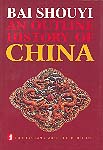Description
China: An Illustrated Introduction
- Author: Li Xuemei
- Translated by Henry Yuan
- Reviewed by Uldis Ozolins
- Order No. 1157
- ISBN-13: 9781622460519
- ISBN-10: 1622460510
- Binding: Paperback
- Publisher: Homa & Sekey Books
- Pub Year: 2022
- Language: English
- Size: 7.5 x 8
- Page: 190
- Price: $34.95. You pay only $20.97 (after 40% discount).
About the Book
Aimed at readers of non-Chinese speakers around the world, the book serves as an easy guide to better understanding China. It offers a concise but wide-ranging presentation to main aspects of the Chinese culture. Within the framework of fifteen chapters, its subjects range from China’s geography and population, places of historic interest, ancient technology and inventions, historical figures and sages, ancient mythology and legends, Chinese proverbs, to Chinese language and characters, as well as traditional Chinese festivals. In a nutshell, it is really a compact tapestry of China’s culture, history and people. While some classic literature on traditional Chinese culture has been referenced throughout the book, it is presented with plain and straightforward language. Also, it features a storytelling style in delivering its content. Without the need for any background information about China, any readers would find the book an interesting, friendly primer to gain the knowledge of a real China.
About the Author
Li Xuemei is an expert on TCFL (teaching Chinese as a foreign language) with publications including Hello, China: A Communicative Coursebook on Chinese. She formerly lectured on translation at University of Venice and on Chinese at University of Padua, and has been dedicated to the overseas teaching of Chinese language. She founded Scuola Internazionale Italo Cinese (SIIC) in 2013 and has been its principal ever since. SIIC is an officially registered and accredited educational institution that is Italy’s and even Europe’s first full-time, bilingual school sponsored by Chinese expats.
About the Translator
Henry Yuan (Qing Yuan) received his MA on translation from Zhejiang University, China. Having worked in several sectors with focus on translation practice, he is currently associate professor at Tourism College of Zhejiang, China, both as teacher of tourism English and trainer for international tour guides. His publications cover academic papers on translation studies and translated photography books. He spent one year as visiting scholar at Translation & Interpreting Program in Western Sydney University, Australia. He is a nationally-certified senior translator and expert member on the Translators Association of China (TAC).
About the Reviewer
Uldis Ozolins is Associate Professor and Head of Program of Languages at the School of Humanities and Communication Arts, Western Sydney University, Australia. He has researched and published widely on Language Policy and on Interpreting and Translation both in Australia and internationally, and runs his own consultancy company Language Solutions. He teaches Business Interpreting and Practicum at WSU, with students both local and international, largely from China and the Middle East. He was originally a political scientist and brings this perspective to his work on applied language study.
Table of Contents
Introduction
Chapter One: An Overview of China
- Physical geography
- Population and nationalities
- Administrative divisions
Chapter Two: Chinese Mountains, Rivers and Lakes
- The spine — mountains
- The arteries — rivers
- The pearls — lakes
Chapter Three: Places of Historic Interest
- The Great Wall
- The Palace Museum
- The Temple of Heaven
- Tiananmen
- The Terracotta Army
Chapter Four: Four Treasures of the Study
- Writing brush
- Chinese ink
- The paper
- The ink stone
Chapter Five: The Four Great Inventions
- Gunpowder
- Compass
- Paper making
- Printing
Chapter Six: The Ancient Technology
- Silk
- The Seismograph and Armillary Sphere
- Circumference ratio
- A master carpenter: Lu Ban
Chapter Seven: Ancient Chinese Sages
- Confucius
- Mencius
- Mozi
- Zhuangzi
- Laozi
Chapter Eight: Historical Figures
- Dayu and flood control
- Returning the jade intact to the State of Zhao
- Emperor Qin’s unification of China
- Sima Qian and The Historical Records
- Zhuge Liang: incarnation of wisdom
- Wu Zetian, the only Empress of China
Chapter Nine: Stories of Child Prodigies
- Kong Rong in a war of words with Li Ying
- Cao Chong weighing an elephant
- Wang Xizhi and the “Writing Brush Rinsing Pond”
- Li Bai — “An iron bar can be ground into a needle”
- Wen Yanbo recovering the ball out of the tree
- Sima Guang with quick wits in an emergency
Chapter Ten: Ancient Mythology of China
- Pangu creating the universe
- Nvwa creating humans and mending the sky
- Hou Yi — a hero shooting down nine suns with arrows
- Jingwei trying to fill up the sea
Chapter Eleven: Popular Chinese Legends
- Butterfly love
- Meng Jiangnv weeping at the Great Wall
- Tale of the White Snake
- Twelve animal signs — Chinese signs of the zodiac
- The old man under the moon
- The Chinese dragon
Chapter Twelve: Ten Chinese Proverbs
- The fox assuming the majesty of the tiger
- Stand by a tree waiting for a hare
- Paint a snake with feet
- Use one’s own spear against your own shield
- Plug one’s ears while stealing a bell
- Misfortune might be a blessing in disguise
- Pulling sprouts up to help them grow
- Blind men feel an elephant
- Mistake the shadow of a bow in one’s cup as a snake
- Three hundred silver dollars were never buried here
Chapter Thirteen: The Chinese language
- The genesis of language
- Languages in China
Chapter Fourteen: The Chinese characters
- Legends on the origin of Chinese characters
- The pictorial origin of Chinese characters
- The evolution of Chinese characters
- The principles of character formation
Chapter Fifteen: Traditional Chinese Festivals
- The Spring Festival
- The Lantern Festival
- The Tomb-sweeping Day
- The Dragon Boat Festival
- The Magpie Festival
- The Mid-Autumn Festival




